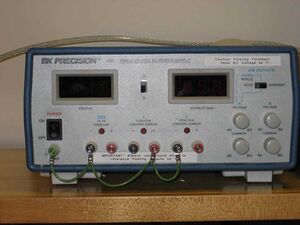Difference between revisions of "BK Precision 1652"
| (2 intermediate revisions by the same user not shown) | |||
| Line 1: | Line 1: | ||
| − | The BK Precision 1652 is a power supply. | + | The BK Precision 1652 is a power supply. |
| − | + | Actually, it is three supplies in one box: two supplies are variable between 0 V and 24 V and are each capable of delivering up to 0.5 A. The third supply is fixed at 5 V and is capable of delivering up to 4 A. | |
| − | [[Image: | + | |
| + | [[Image:BK_1652.jpg|thumb|BK Precision 1652 Power Supply]] | ||
== Specifications == | == Specifications == | ||
| − | <ref name="BK">[http://www.bkprecision.com/products/categories/sub_categories/models/?model=1652 Triple Output Digital Display DC Power Supply], BK Precision</ref> | + | === Output A <ref name="BK">[http://www.bkprecision.com/products/categories/sub_categories/models/?model=1652 Triple Output Digital Display DC Power Supply], BK Precision</ref> === |
| + | |||
| + | Adjustable 0 to 24 Volts up to 0.5 Amps | ||
| + | |||
| + | === Output B === | ||
| + | Adjustable 0 to 24 Volts up to 0.5 Amps | ||
| + | |||
| + | === FIXED Output === | ||
| + | 5 Volts up to 4 Amps | ||
== Use == | == Use == | ||
| − | + | Obviously, the power supply is used to power circuits built in the BME153/BME154 lab (duh!). | |
| − | + | ||
| + | In BME153, generally one uses just the A output in a unipolar configuration. The display selector is set to A, of course, and the tracking is set to Independent or Series. The output voltage is adjusted and the maximum output current is adjusted. This current limit could be adjusted to its maximum, but it's probably a good idea to adjust this to the lowest level necessary. That way, if something is wrong, the damage will be limited. | ||
| + | |||
| + | To power, say, opamps in BME154, you need a bipolar supply. In that case switch the tracking to Series. Be sure to attach the ground strap between the red lead of B and the black lead of A. Now the red lead of A is a positive voltage and the black lead of B is a negative voltage. The A control controls both outputs and the B control does nothing. | ||
| + | '''Beware the red lights.''' If you see one of the red Overload lights, you have a problem. You should immediately turn off the power supply and find the problem. | ||
== Questions == | == Questions == | ||
| Line 16: | Line 29: | ||
== External Links == | == External Links == | ||
| + | [http://www.bkprecision.com/products/docs/manuals/1652_manual.pdf User Manual] | ||
== References == | == References == | ||
<references /> | <references /> | ||
Latest revision as of 21:08, 13 February 2009
The BK Precision 1652 is a power supply.
Actually, it is three supplies in one box: two supplies are variable between 0 V and 24 V and are each capable of delivering up to 0.5 A. The third supply is fixed at 5 V and is capable of delivering up to 4 A.
Contents
Specifications
Output A [1]
Adjustable 0 to 24 Volts up to 0.5 Amps
Output B
Adjustable 0 to 24 Volts up to 0.5 Amps
FIXED Output
5 Volts up to 4 Amps
Use
Obviously, the power supply is used to power circuits built in the BME153/BME154 lab (duh!).
In BME153, generally one uses just the A output in a unipolar configuration. The display selector is set to A, of course, and the tracking is set to Independent or Series. The output voltage is adjusted and the maximum output current is adjusted. This current limit could be adjusted to its maximum, but it's probably a good idea to adjust this to the lowest level necessary. That way, if something is wrong, the damage will be limited.
To power, say, opamps in BME154, you need a bipolar supply. In that case switch the tracking to Series. Be sure to attach the ground strap between the red lead of B and the black lead of A. Now the red lead of A is a positive voltage and the black lead of B is a negative voltage. The A control controls both outputs and the B control does nothing.
Beware the red lights. If you see one of the red Overload lights, you have a problem. You should immediately turn off the power supply and find the problem.
Questions
Post your questions by editing the discussion page of this article. Edit the page, then scroll to the bottom and add a question by putting in the characters *{{Q}}, followed by your question and finally your signature (with four tildes, i.e. ~~~~). Using the {{Q}} will automatically put the page in the category of pages with questions - other editors hoping to help out can then go to that category page to see where the questions are. See the page for Template:Q for details and examples.
External Links
References
- ↑ Triple Output Digital Display DC Power Supply, BK Precision
